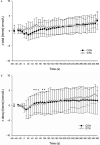Muscle blood flow is independent of conduit artery diameter following prior vasodilation in males
- PMID: 33427413
- PMCID: PMC7798049
- DOI: 10.14814/phy2.14698
Muscle blood flow is independent of conduit artery diameter following prior vasodilation in males
Abstract
At the onset of exercise in humans, muscle blood flow (MBF) increases to a new steady-state that closely matches the metabolic demand of exercise. This increase has been attributed to "contraction-induced vasodilation," comprised of the skeletal muscle pump and rapid vasodilatory mechanisms. While most research in this area has focused on forearm blood flow (FBF) and vascular conductance, it is possible that separating FBF into diameter and blood velocity can provide more useful information on MBF regulation downstream of the conduit artery. Therefore, we attempted to dissociate the matching of oxygen delivery and oxygen demand by administering glyceryl tri-nitrate (GTN) prior to handgrip exercise. Eight healthy males (29 ± 9 years) performed two trials consisting of two bouts of rhythmic handgrip exercise (30 contractions·min-1 at 5% of maximum) for 6 min, one for each control and GTN (0.4 mg sublingual) condition. Administration of GTN resulted in a 12% increase in resting brachial artery diameter that persisted throughout the duration of exercise (CON: 0.50 ± 0.01 cm; GTN: 0.56 ± 0.01 cm, p < 0.05). Resting FBF was greater following GTN administration compared to control (p < 0.05); however, differences in FBF disappeared following the onset of muscle contractions. Our results indicate that the matching of FBF to oxygen demand during exercise is not affected by prior vasodilation, so that any over-perfusion is corrected at the onset of exercise. Additionally, our findings provide further evidence that the regulation of vascular tone within the microvasculature is independent of the conduit artery diameter.
Keywords: exercise hyperemia; muscle pump; vascular tone; vasodilation.
© 2021 The Authors. Physiological Reports published by Wiley Periodicals LLC on behalf of The Physiological Society and the American Physiological Society.
Conflict of interest statement
None declared.
Figures






Similar articles
-
Attenuated forearm vascular conductance responses to rhythmic handgrip in young African-American compared with Caucasian-American men.Am J Physiol Heart Circ Physiol. 2018 Nov 1;315(5):H1316-H1321. doi: 10.1152/ajpheart.00387.2018. Epub 2018 Aug 17. Am J Physiol Heart Circ Physiol. 2018. PMID: 30118345 Free PMC article.
-
Contributions of acetylcholine and nitric oxide to forearm blood flow at exercise onset and recovery.Am J Physiol. 1997 Nov;273(5):H2388-95. doi: 10.1152/ajpheart.1997.273.5.H2388. Am J Physiol. 1997. PMID: 9374776
-
Fatigue-independent alterations in muscle activation and effort perception during forearm exercise: role of local oxygen delivery.J Appl Physiol (1985). 2019 Jul 1;127(1):111-121. doi: 10.1152/japplphysiol.00122.2019. Epub 2019 May 9. J Appl Physiol (1985). 2019. PMID: 31070953 Free PMC article.
-
The contribution of red blood cell desaturation to exercising skeletal muscle vasodilation heterogeneity.J Appl Physiol (1985). 2025 Jun 1;138(6):1435-1448. doi: 10.1152/japplphysiol.00136.2025. Epub 2025 May 8. J Appl Physiol (1985). 2025. PMID: 40338242
-
Effect of unilateral forearm inactivity on endothelium-dependent vasodilator function in humans.Eur J Appl Physiol. 2013 Apr;113(4):933-40. doi: 10.1007/s00421-012-2505-7. Epub 2012 Sep 29. Eur J Appl Physiol. 2013. PMID: 23053126
References
-
- Buckwalter, J. B. , & Clifford, P. S. (2001). The paradox of sympathetic vasoconstriction in exercising skeletal muscle. Exercise and Sport Sciences Reviews, 29, 159–163. - PubMed
-
- Chen, Z. , & Stamler, J. S. (2006). Bioactivation of nitroglycerin by mitochondrial aldehyde dehydrogenase. Trends in Cardiovascular Medicine, 16, 259–265. - PubMed
MeSH terms
Substances
LinkOut - more resources
Full Text Sources
Other Literature Sources
Medical
Miscellaneous

